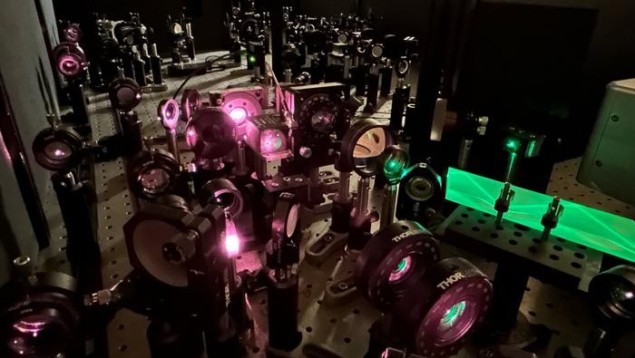Quantum fluctuations are controlled for the first time, say optics researchers
07 Aug 2023
Quantum control: the experimental setup used to generate tunable random numbers from vacuum fluctuations. (Courtesy: Charles Roques-Carmes, Yannick Salamin)
A new technique for exploiting the random energy fluctuations present in empty space and biasing the fluctuations with an applied field has been demonstrated by US scientists. The researchers believe the technique could have applications from sensing to random number generation in probabilistic optical computing.
Just as it forbids a particle from being completely bereft of momentum, Heisenberg’s uncertainty principle prevents a system from being totally devoid of energy. In quantum mechanics, therefore, a vacuum is populated by tiny fluctuations in the electric field at random frequencies. These are normally too small to be experimentally relevant, but in specific situations they can become important.
In 2021, for example, theoretical physicist Ortwin Hess of Trinity College Dublin and colleagues led by Hui Cao at Yale University in Connecticut utilized these fluctuations to produce a random number generator from a multi-mode laser. “In the laser description we used back then, [we described] the unpredictability and the beating that would result from the many modes interacting,” explains Hess; “but that was a very interesting consequence that allowed the harvesting of the quantum fluctuations.”
Random difficulties
Despite widespread use in cryptography and computer simulations, sets of true random numbers are notoriously difficult to generate. This makes Cao and Hess’ work of great interest outside of the field of quantum optics.
In the new work, researchers at the Massachusetts Institute of Technology (MIT) took this concept a step further by applying an external signal to interfere with the quantum fluctuations and measuring the effect of this interference. Yannick Salamin, Charles Roques-Carmes and colleagues placed a lithium niobate crystal in an optical cavity and pumped it with photons from a laser. This generated excited states in the crystal that decayed to produce two photons of exactly half the energy of the pump photons.
“The phase that these photons will have is completely random because they are triggered by the vacuum fluctuations,” explains Salamin, “but now the photon will circulate in the cavity and, when the next photon comes, it can give energy to that same photon and amplify it. But because of the physical nature of the effect, only two possible phases can be amplified.”
Bifurcation transition
Photons are initially amplified with both phases, but the system undergoes a “bifurcation transition” and picks one mode or the other as soon as enough energy accumulates in that mode to overcome losses. “Once you’re in the steady state, the outcome is fixed,” explains Roques-Carmes. “If you want to get a new sample, you have to restart the whole process, go back to the vacuum distribution and go through the bifurcation again,” he adds.
When no external bias was applied, the cavity was equally likely to end up in either of the two possible modes, and the relative frequencies of various combinations of outcomes after repeated trials formed a perfect Gaussian distribution. The researchers then applied a pulsed electromagnetic field attenuated until it was on the order of the vacuum fluctuations. They found that, though the system could still settle down into either state, they could bias the probability that it would pick one state over the other. When they applied a stronger bias, the system consistently picked the same state.READ MORE

The team is now studying possible applications, including probabilistic computing. “The general idea is that by coupling many p-bits [probabilistic bits] together we can build a p-computer,” says Roques-Carmes. “There are many areas of science where you want to be able to encode uncertainty…We plan to take this photonic p-bit and incorporate it into a photonic processing unit.” The research are also investigating the possibility of using the system’s responsiveness to small electric fields to produce a sensor.
The research is described in Science and Hess is keen on the results described in the paper. “It’s quite exceptional, because it’s almost like you bias things with nothing,” says Hess, who was not involved in this latest work. “What impressed me is that they have a very nice way of writing the manuscript – they link it up very strongly with some of the grand masters of laser science such as Lamb and Purcell – they cite Hawking and Unruh. In the 1950s and 1960s it really wasn’t clear how many of these processes came about and how fluctuations can be changed by where they happen…There’s a lot more applications in which one could use this, but from a fundamental point of view I’m just impressed by the fact that they’ve shown experimentally that quantum statistics is still quantum statistics even if it’s biased in some way.”
Tim Wogan is a science writer based in the US/
FROM PHYSICSWORLD.COM 8/8/2023

Δεν υπάρχουν σχόλια:
Δημοσίευση σχολίου